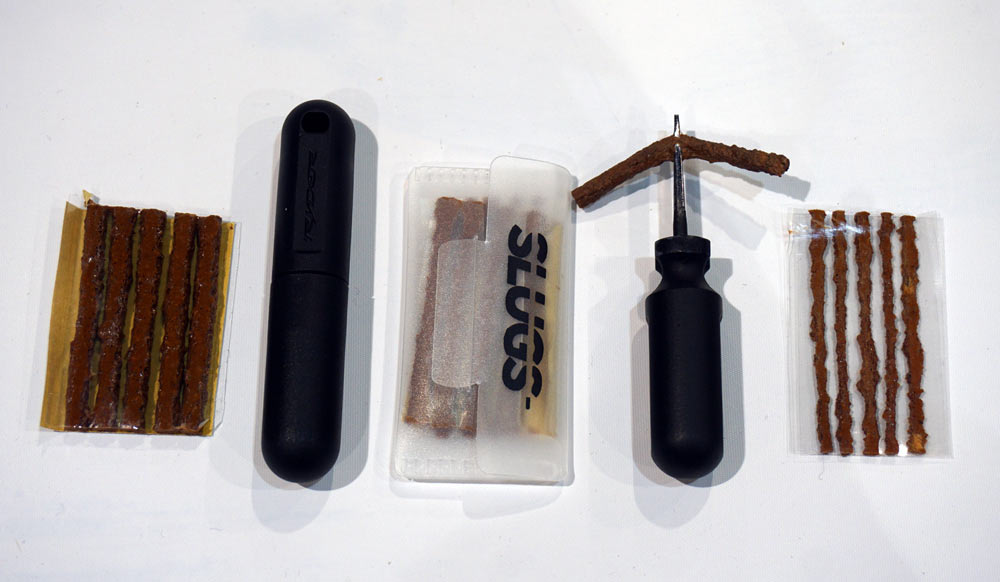Even with the best tires in the world, flats happen. Fortunately, in addition to improvements in tire construction there have also been improvements in repairing or plugging tools. Rather than a patch like you might be used to with a tube, pluggers use a sticky plug, or in this case a Slug, that you push into the tire. Do it right, and you’re left with an air tight tire that will get you back on your way.
Based out of South Africa, Ryder Cycling is a brand that started in the 90’s with their own water bottles. Over the years, their product line has grown to include products like the Slug Plug, the Nutcracker, and the Slyder storage system to get you back up and rolling. So for this AASQ installment, we gave Nico Ferreira and the Ryder team a chance to answer your best questions when it comes to plugging holes and saving rides!
What makes the Slug Plug different than other plugging tools on the market?
Ryder: The SlugPlug has a few unique features over the basic initial screwdriver type tool that’s been used for years.
- It can be preloaded.
- There’s a cover so the sharp point is out of harm’s way.
- It’s got a Slug Catcher so that when you insert the Slug, it doesn’t go too far and there will always be a bit sticking out (see our video above to explain this).
- It has a Presta Valve Core Remover.
- It’s tiny, very easy to carry, and beautifully shaped to slip into a pocket or a bag.
Plugs work great for a temporary repair. I’ve had them come out on later trail rides. How do you recommend patching tubeless tires in a more permanent way? – Kris
Ryder: Kris, first and foremost, the SlugPlug system is to get you home. Subsequent riding with the SlugPlug is debatable. We know people who have used them for a long time but it’s the same as when you’ve patched the tube. You are never quite sure if that patch is going to come loose. You’ll probably find that if it holds on the first few rides after you’ve plugged the tyre it will hold for a longer period. If, however it starts leaking, perhaps it would be best to change the tyre. You may have experienced a situation where you put a brand new tyre on a rim, fill it with sealant and pump it up and the next morning it’s flat – it just hasn’t taken. You repeat the pumping up and it continually comes down – it just hasn’t made a good seal. Once however it has sealed, the chances are you are not going to have a problem again unless you burst the tyre while riding and it breaks that seal. It’s pretty much the same with Slugs: if they work well after you’ve used them, they probably going to work well for a while. There have been one or two solutions by putting patches in from the inside: and it’s actually something we’re working on at the moment but there is nothing that is as strong as the original bonded tyre. Pressure from the inside will always have a problem where you’ve got a cut which is continually giving problems.
Does a plug improve in performance over time? Do I need to clean/dry any sealant in the area of the puncture? What about trimming the length of plug that is sticking out, is that required? I recently repaired a puncture with my Slug Plug and barely made it home, the next morning my tire was flat as a pancake but after waiting a couple days the plug seems to be holding air OK. – Erin
Ryder: Erin, that could possibly be because you added some more sealant when you got home or the sealant that was already in the tire had a chance to set up over time. Also, when you reinflated the tire at home, you forced more sealant from the tyre and it filled the holes. The rule is simply this, make sure the plug is the right size and that you’ve always got sealant and it will work. The only time it won’t work is when the hole is simply too big.
What is the longevity of a plug (slug)? Can they be considered a permanent repair for a hole to large for sealant to plug or they really just to get you back to base. – Stephen
Ryder: Stephen, as mentioned, the SlugPlug is first and foremost to get you back home. We’ve had people who’ve ridden with SlugPlugs in long term, and if they haven’t had problems. It’s the same when you initially put the tubeless system together. If it doesn’t seal perfectly it will go down overnight: you then pump it up again and the same type of thing happens, and you have to reseat it on the rim and hopefully it works next time. In the same way a Slug can be considered permanent but it’s not the ideal solution especially on long remote rides or races.
Why are plugs so skinny? If the hole is big enough to need a plug I usually find the usual skinny bike plugs are too small for one to work. I buy motorcycle tire plugs and cut them down. Bigger plugs please. Thanks. – David
Ryder: Good point David. But the reason we include different size Slugs is to join them together i.e. put them alongside one another and twist. Then you’ve got 1.5mm, 3mm, 3.5mm (the bigger one) and of course 5mm if you take a 3.5mm Slug and add a 1.5mm Slug to it. Motorcycle plugs could work but we feel it’s better to use the Slugs to give yourself varying size combinations by twisting smaller plugs together.
Is it ok to use more than one plug to fill bigger holes?
Ryder: Yes, you can add Slugs by putting in one and reloading: better still, take one of the 1.5mm Slugs and twist it together with a 3.5mm Slug and use that for bigger holes.
Do you need to clean the residue of Stan’s (or whatever) off the inside of your tire with any special product/technique before trying to patch the tire? – Samuel
Ryder: Samuel, putting in a Slug won’t be affected if there’s sealant in and around the hole. The problem is if you don’t have sealant in the tire, it’s not really going to work because the Slug will fill the majority of the hole but the other little openings around it won’t be filled by the sealant.
The point of a plugging system like the SlugPlug is that you can repair the tire without having to take it off the rim or break the bead. The SlugPlug allows you to seal it from the outside rather than removing the tire to “patch” it from the inside. Have a look at our video above to get a good idea how to use the SlugPlug.
How do you get the plug to actually bond with the tire rubber? Any time I have tried to plug a slice in a tubeless tire out on the trail, there has been Stans all over everything. It seems like the Stans makes it impossible for the plug to actually bond with the tire, and the plug doesn’t actually seal the hole.- Sean
Ryder: Clearly the Slug you are using is not big enough. Most people will put in say one thick Slug and if it’s still leaking, they put in a second (good news, we’ve got a product coming out to make this even easier). The rule is to put in the right Slug (or Slugs) or a combination of the 3.5 and a 1.5 and if you have sealant in the tyre it will close.
Is it really necessary to use a reamer tool before installing the plug?
Ryder: No, we don’t believe so. This is a carryover from the product’s initial application in motor vehicle tyres and it’s not necessary to use it for bicycle tires.
Are there any sealants that seem to work better with plugs than others?
Ryder: Get the advice of your local cycle dealer – they would’ve had experience on which are the best sealants to use. Some are certainly better than others.
Is the Slug Plug appropriate for high-pressure road tires? Any special techniques needed? Thanks! – Tom
Ryder: Tom, at the moment, the Slugs are not designed for high pressure tyres: but they can be used and sometimes they work. The problem is the pressure in a road bike is often 3 times as much as a mountain bike and it really just depends on how well you put in the Slug, and the shape of the hole as to whether it will hold to get you back home. Just to let you know we are working on a road tubeless repair system which will be different to the Slug system. In the mean time, if you do puncture on a road tubeless system, give the SlugPlug a try and you might get lucky, but remember it will require sealant to be air tight.
Will the plugs work on tires with relatively slick middles, like the WTB Exposure 32? – Deborah
Ryder: Deborah, whether it’s slick or aggressive tread, SlugPlug works just as well at lower pressures. For higher pressure slicks, see the answer above.
If you have to, can you put a tube in a tire that’s been plugged?
Ryder: Yes, that’s certainly no problem, it won’t affect the tube.
Any tips for best chances when using tire plugs to temporarily fix a smaller sidewall cut? I know it’s not the ideal approach, but much faster and easier than using a tube and boot so worth a shot. –Bill W
Ryder: Bill, smaller holes should be sorted with sealant. It’s good to check every say 3 months to see that you have enough sealant and that it hasn’t dried up. You also want sealant which has got tiny particles as that makes it more effective with helping the sealant fill holes. Find out from your local cycle store which sealant he deems most effective – he’ll have experience with it. If it still won’t seal the SlugPlug is the answer. The thinner Slugs are 1.5 so when you double them over, they should close a hole 2–3mm (remember the Slug is not going to be the perfect shape of the cut). If that doesn’t work, then the thicker 3.5mm Slug. If you feel it’s in-between, take 2 x 1.5 Slugs and well them together, thread them through the eye and try that.


